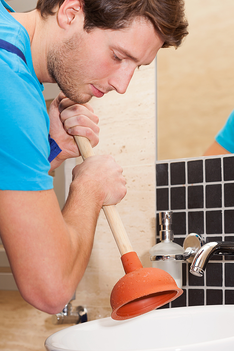How do you feel in regards to Tips on How to Effectively Use a Plunger?

Introduction
Proper maintenance of household drains is essential for preventing clogs and ensuring smooth water flow. One of the key tools in every homeowner's toolkit is the plunger, alongside various drain cleaners designed to tackle stubborn clogs effectively. This article explores how to use plungers and drain cleaners effectively to keep your drains flowing freely.
Section 1: Understanding Drain Cleaners
Types of Drain Cleaners
Drain cleaners can be chemical or enzymatic. Chemical cleaners use strong chemicals to dissolve clogs, while enzymatic cleaners use natural enzymes to break down organic matter.
How Drain Cleaners Work
Chemical cleaners react with clogs to dissolve them, while enzymatic cleaners break down organic materials like hair and grease without harming pipes.
Safety Considerations
Always wear gloves and eye protection when using chemical drain cleaners. Ensure adequate ventilation and follow manufacturer instructions carefully.
Eco-Friendly Alternatives
Consider using vinegar and baking soda or enzyme-based cleaners for eco-friendly options that are safer for pipes and the environment.
Section 2: Understanding Plungers
Types of Plungers
There are several types of plungers available, each designed for different types of drains and clogs. The most common types include cup plungers, flange plungers, and accordion plungers.
How Plungers Work
Plungers work on the principle of creating pressure and suction to dislodge clogs. When properly applied over a drain, they create a vacuum that can pull out debris or break up blockages.
Choosing the Right Plunger
Selecting the right plunger depends on the type of drain and the nature of the clog. Cup plungers are ideal for sinks and tubs, while flange plungers are better suited for toilets due to their design.
Common Mistakes with Plungers
Avoiding these mistakes ensures effective plunging: improper seal around the drain, insufficient force, and not clearing surrounding debris.
Section 3: Using Drain Cleaners Effectively
Application Techniques
Pour chemical cleaners directly into the drain opening. Allow them to work for the recommended time before flushing with hot water. Enzymatic cleaners should sit overnight.
Precautions
Avoid mixing different types of cleaners, as this can produce toxic fumes. Never use chemical cleaners in conjunction with a plunger, as splashing can occur.
Handling Stubborn Clogs
For persistent clogs, consider using a plumbing snake or calling a professional plumber to prevent damage to pipes.
Section 4: Using Plungers Effectively
Preparation
Before plunging, ensure the plunger covers the drain completely and forms a tight seal. Clear any visible debris around the drain opening.
Technique
Start with gentle plunging motions to build suction. Increase pressure gradually, using a steady rhythm. Repeat as necessary until the drain clears.
Troubleshooting Tips
If plunging doesn't work, try adjusting the seal, applying petroleum jelly for a better seal, or using a different type of plunger.
Conclusion
In conclusion, understanding how to use plungers and drain cleaners effectively is essential for maintaining healthy plumbing systems. By choosing the right tools and techniques, homeowners can tackle minor clogs and prevent major plumbing issues down the line.
A Guide to Plungers (and How to Use Them)
Why to Use a Plunger
Many people’s first instinct when they have a clog is to pour store-bought drain cleaner down the drain, but this is actually harmful to your pipes. Liquid drain cleaners are full of caustic chemicals that eat away at clogs to get rid of them, but the problem is they also eat away at your pipes. Using store-bought drain cleaners will eventually cause leaks in your pipes, which is much more difficult and costly to fix than a simple clog.
How to Use a Plunger
First things first, you need to know the different kinds of plungers and how they work. There are two types of plunger, cup plungers and flange plungers.
Cup Plunger
Cup plungers are the most common style of plunger, with a rubber cup attached to a long wooden handle. This type of plunger is best for using on flat-surface drains like those found in bathtubs, showers, and sinks. They can be used on the curved drains of toilets but are not as effective as flange plungers for this job.
Flange Plunger
Flange plungers look like cup plungers but have an additional rubber ring, or flange, around the cup. The rubber flange allows you to get a good seal around a curved drain, so these plungers are especially effective on toilets. They can be used on flat-surface drains as well, but are not as effective as cup plungers. For the best results you should have a flange plunger for toilets and a cup plunger for sinks, showers, and tubs.
Plunger Technique
For sinks, tubs, and showers, use a cup plunger. If there is a lot of water in the sink or tub, you may want to remove some with a bucket to reduce the mess while you plunge. Place the cup of the plunger securely over the whole drain and gently push down on the handle in order to create a seal. Now you can thrust the plunger down in quick, repetitive movements, making sure not to lift the handle up enough to break the seal. Continue for about 30 seconds.
For toilets, use a flange plunger. Wait a few minutes after flushing the toilet to let the water level go down. Insert the plunger into the toilet drain so that the rubber flange is inside the drain, creating a seal. Move the plunger up and down in quick thrusts for about 30 seconds.

I found that page about Here's How to Correctly Use a Toilet Plunger while doing a search on the internet. Liked our review? Please share it. Help other people find it. I treasure your readership.
Maintenance Sign-Up
Comments on “How to Employ Plungers and Drain Cleaner Properly: Pro Tips”